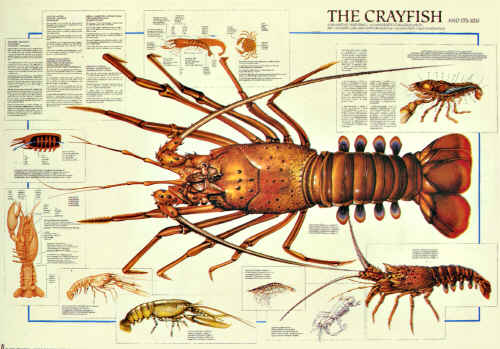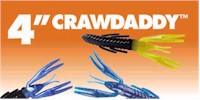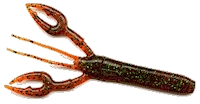Figurin' Out Craws Without A Cray
You
don't need a Cray computer to figure out crayfish.
In fact, we'll tell you how you can figure them out -
where they'll be, what color lures imitate them - without ever
seeing one.
Why the interest? Experts always
tell us that crayfish are one of the major baits in the diets of
all species of bass everywhere. But let's hold that crayfish
thought (Watch the claws!) for a minute so that we can review the
other important food sources for bass too, okay?
Insects. In the beginning of their
life, bugs are nutritious, small morsels for a growing bass.
However, a bass is generally weaned off insects as it quickly
outgrows its juvenile phase. Sure, they will still take
bulky-sized bugs whenever they can, and in some remote ponds and
streams that I go to, the adult bass continue to feed like trout
on insects and their hatches because there really isn't anything
much more than bugs, flies and nymphs for bass to eat.
Preyfish. In most places however,
adult bass tend to become piscavorous - fish eaters.
They'll pursue whatever is the most plentiful and easily
attainable prey fish (or fish-like critters), including:
- Open water pelagics: (shiners, shads,
herring, alewives, silversides, etc.). Some bodies of water have
LOTS of pelagics. In such waters, bass focus lots of their time
and activities around these pelagics. In some waters, for
instance, it may become unproductive to fish shoreline cover at
night because bass are focusing themselves on eating mid-lake
pelagics by day.
- Cover-oriented species (yellow perch,
sunfish, crappies). Other waters have no pelagics, but plenty of
juvenile panfish, and bass will orient their diets and feeding
habits to intercept these young panfish.
- Bottom-oriented species (juvenile cats,
chubs, sculpins, darters, leeches, tadpoles, etc.). There are
some cold lakes up north where leeches are a prominent part of
the prey biomass, and I know some small ponds that get filled to
the brim with pollywogs come spring!
So, pelagic, cover-oriented, or bottom-oriented fish and
fish-like critters typically are the most important item in the
adult bass diet.
 Crayfish.
Where they exist (which is practically everywhere), crayfish
typically become the SECOND most important item (after preyfish)
in an adult bass diet. Unbeknown to most anglers, many bodies of
water are infested with crayfish. But unless you start
overturning underwater rocks or pulling up water weeds, you may
never see many crayfish. They change their colors to blend in
perfectly, and they usually hide in the bottom by day. Even if
caught out in the open, they can scoot backwards so quickly that
the human eye can not really follow them! But even though we may
not see crays from day to day, it is safe to assume they can be a
plentiful food source for bass on most waters. Therefore, it is
in our best interest to learn as much as we can find out about
these mysterious critters. Crayfish.
Where they exist (which is practically everywhere), crayfish
typically become the SECOND most important item (after preyfish)
in an adult bass diet. Unbeknown to most anglers, many bodies of
water are infested with crayfish. But unless you start
overturning underwater rocks or pulling up water weeds, you may
never see many crayfish. They change their colors to blend in
perfectly, and they usually hide in the bottom by day. Even if
caught out in the open, they can scoot backwards so quickly that
the human eye can not really follow them! But even though we may
not see crays from day to day, it is safe to assume they can be a
plentiful food source for bass on most waters. Therefore, it is
in our best interest to learn as much as we can find out about
these mysterious critters.
At what temperatures and locations would you START
using crawfish lures in early spring?
Crayfish, like many other species of crustaceans, amphibians,
reptiles and insects, bury under the mud in late fall to
hibernate for the winter. I wouldn't worry about when they start
moving about because it is pretty early in the season. They'll
usually be out of the mud before you and I begin fishing! All
these critters gravitate towards the sun-baked, wind-protected
shorelines to start renewing their life energies for another
season.
At what depth or time of year should you STOP fishing
crawfish imitations?
I wouldn't stop imitating them at any depth. You can catch
bass on a crayfish imitator at any depth, temperature or time of
year. Whether the bass believe they are actually biting a
crayfish or not, we will never know, but bite they will! Of
course, if the bass are down 40 feet under big schools of shad,
your crayfish imitator may just be mistaken for a shad by the
bass!
What are the ideal circumstances for crayfish?
Most crayfish prefer nicely-oxygenated water, which is usually
right from the shoreline to about 20 feet deep. The species does
make seasonal migratory movements from its local wintering
grounds to its local summering grounds. As the seasons turn, they
may migrate out of locations that stress them and into locations
that provide a more hospitable environment. They tend to form
colonies in the most hospitable areas. Especially in hot summer
months, bottoms underneath dense weed beds (with non-stagnant
water) are favored crayfish locations. Of course, they love
living under rocks, under logs, or under anything else that can
serve them as a hidey-hole. They will form colonies of burrows in
hard clay bottoms, and pile up their diggings by the entrances to
their burrows.
What colors imitate crayfish?
Crayfish bodies have light-sensitive cells called
chromatophores that automatically adjust the mix of colors that
the cells "expose" to the outside world, thereby
allowing the crayfish to automatically match its color to
wherever it spends most of its time. Their PRIMARY colors are
shades of black, brown, green, or grey. On their pincers, their
backs and lower fringes of the carapace, they have distinctive
SECONDARY color accents, various traces such as blue, red,
orange, white, yellow, or amber.
Just like the crayfish automatically matches its colors to its
location, you should match your imitation craw colors to whatever
color closely approximates the water color, the vegetation color,
and the bottom and cover color of the area you are currently
fishing. You can even micro-tune into the unique color of a
particular weed bed, mud bar or crayfish-infested rock pile. As a
rule, think darker - crayfish usually spend most of their time
hidden under something or buried into the bottom by day. They
usually come out to forage under darkness of night. There are two
ways you can accomplish this "darkness" with lures.
First, you can use opaque (non-see through) colors that are
slightly darker than the water, vegetation, cover and bottom.
Second, you can use soft plastic colors that are semi-translucent
(see through). Just pick a translucent color that matches the
water, vegetation, cover, bottom color. As the translucent lure
comes in and out of underwater shadows and climbs up or down in
depth, the translucence allows it to blend into its background
better. For example, when fishing tannin-stained waters or over
reddish-brown mud or clay bottoms, you could try a jig 'n pig
with an opaque pumpkin-orange skirt and a translucent pumpkin
soft plastic trailer. Click here to read other examples of when to
use greener/browner baits in summer.
Yamamoto soft plastics come in 100 different colors, so it
provides us with an ample palette to pick off some of my favorite
craw-imitiating colors.
| 021 Black w/ Large Blue Flake |
296 Rootbeer w/ Black & Dark
Green |
| 051 Black w/ Small Red Flake |
236 Smoke Rootbeer w/Green &
Copper |
| 208 Watermelon w/ Black & Red |
163 Smoke w/ Black & Copper |
Summer softshells are delectable!
Like most crustaceans, crayfish can molt during any month when
their metabolisms are high and whenever they need some growing
room inside of their shells. This molting season usually is the
few months from late spring through late summer. A soft shell
crayfish often takes on a pale smoky, almost milky translucent
color with white, orange and powder blue accents. The accents
start out drab, turn quite brilliant as the shell hardens, and
then fade out as the hard shell reverts to the prevailing bottom
color. Bass find softshells to be delectable, and I think this
molting pattern can be imitated with a smoke-colored soft plastic
lure. I like the Yamamoto colors #163 and #200 for this as well
as the Kalin's color #455. I make my own fiberguard jigs, and I
make a tri-tone fiberguard using clear, blue, and orange fibers
to further trigger a "soft craw" resemblance to the
bass!
Short Stubby Craws Work Well
I've used a lot of soft plastic crayfish in my time. Some were
ultra-realistic models of the real thing. Others did not
necessarily look realistic, but had thin worm bodies bulging out
with exaggerated claws and antennaes far bigger than any living
craw. Regardless of whether they were ultra-realistic or not,
they all caught well for me in their time.
Anyway, I keep trying different stuff as far as fishing goes.
Manufacturers are good like that. This season, I have begun
favoring a few styles of craws (see below) that match a stubby,
cylindrical profile. I started to favor these particular craw
styles over all others because they imitate the claw, leg and
body posture of a backward-scooting crayfish, which tucks in it's
claws and legs, and tucks its tail under its belly, therefore
appearing...well...cylindrical and stubby.
How does this posture look on a real craw?
Well, take a look at a real craw that croaks in your bait
bucket. The wide fan tail folds in on itself, bends and folds
under the mid-section. The legs and claws fold in on themselves
too. It almost takes onthe appearance of a compact crayfish
"pellet" for lack of a better word. Now that's the same
posture when they scoot too! And that's what you should attempt
to imitate with Texas-rigged craw lures. Now, the bass I catch
have no doubt seen this scooting "posture" a-plenty,
and I feel the following few lures trigger bass after live craws
better than the craw lures with the big exaggerated claws or with
the ultra-realistic details.
Another point is the compact size of the
following lures. Some of the craw lures on the market are big,
floppy ones up to 6" sizes. But I know an awesome live
crayfish expert who is clearly convinced that bass bass prefer
the shortest-bodied, smallest-clawed craws instead of big ones.
In fact, he catches more and bigger bass on 2 to 3 inch long
crayfish than he does on larger 'dads.
 1) Gambler 4" Crawdaddy. This
lure has a "fat" body that is intentionally designed
for use on Gambler's screw-in Florida Rig! Bass love nothing more
than a vulnerable craw scooting tail-first across the bottom
frantically looking for a place to dig in or hide under! The
Crawdaddy's claws and legs are tucked in close to the body, and
the body is cylindrical. And that's exactly the shape and
claw/leg posture of a backwards-scooting, crawdad - hunched over
with the appendages tucked in. Son, stick a Florida Rig in this
one - and call in sick to work! Work it through rocky, weedy,
shallow cover where craws hide. Choose colors to match the water,
weed, and bottom colors where you will be tossing it. Make it
scoot and pause like real. Bounce it into obstructions, then kill
it. Jiggle it in place on the bottom, then let it lie motionless.
Expect to get bit when it's motionless. Often you will not feel a
hit, your line will just start swimming off or feel heavy. Expect
BIG bass! 1) Gambler 4" Crawdaddy. This
lure has a "fat" body that is intentionally designed
for use on Gambler's screw-in Florida Rig! Bass love nothing more
than a vulnerable craw scooting tail-first across the bottom
frantically looking for a place to dig in or hide under! The
Crawdaddy's claws and legs are tucked in close to the body, and
the body is cylindrical. And that's exactly the shape and
claw/leg posture of a backwards-scooting, crawdad - hunched over
with the appendages tucked in. Son, stick a Florida Rig in this
one - and call in sick to work! Work it through rocky, weedy,
shallow cover where craws hide. Choose colors to match the water,
weed, and bottom colors where you will be tossing it. Make it
scoot and pause like real. Bounce it into obstructions, then kill
it. Jiggle it in place on the bottom, then let it lie motionless.
Expect to get bit when it's motionless. Often you will not feel a
hit, your line will just start swimming off or feel heavy. Expect
BIG bass!
 2) Gary Yamamoto's 3 3/4" Baby Craws.
Most of the craws you see on the market are "craw
worms," which have flat, floppy craw heads/claws stuck on
thin 6" worm tails. The overall design is that of a crawfish
lollipop, right? But not the new Yamamoto Craws. The body is fat,
wide, and almost cylindrical from end to end, like the body on a
fat twister tail grub - except with claws instead of a twister
tail. The claws are only slightly exaggerated - they're just
right! The claws stay tucked in close, just the right posture for
a backward-scooting craw effect. For spooky fish in clear water,
I usually go to a 3" Baby Craw rigged on a "Texas
jig" (a lead head molded onto an offset shank Texas rigging
hook). A Texas jig and Baby Craw presents a simple "do
nothing" profile and action that is often required in clear,
tough finesse situations. 2) Gary Yamamoto's 3 3/4" Baby Craws.
Most of the craws you see on the market are "craw
worms," which have flat, floppy craw heads/claws stuck on
thin 6" worm tails. The overall design is that of a crawfish
lollipop, right? But not the new Yamamoto Craws. The body is fat,
wide, and almost cylindrical from end to end, like the body on a
fat twister tail grub - except with claws instead of a twister
tail. The claws are only slightly exaggerated - they're just
right! The claws stay tucked in close, just the right posture for
a backward-scooting craw effect. For spooky fish in clear water,
I usually go to a 3" Baby Craw rigged on a "Texas
jig" (a lead head molded onto an offset shank Texas rigging
hook). A Texas jig and Baby Craw presents a simple "do
nothing" profile and action that is often required in clear,
tough finesse situations.
 3) Venom 4" Clickin
Craw. The 4" size is great as a trailer on skirted jigs
- or alone on a jig head, Texas or short Carolina rig. Usually, I
prefer both the jig options - unless weeds are too heavy which is
when I'll opt for the weed-free Texas rig or short Carolina rig.
Design features include the extra long thin antennae, long thin
claws, and the two-tone colors that do make a difference! 3) Venom 4" Clickin
Craw. The 4" size is great as a trailer on skirted jigs
- or alone on a jig head, Texas or short Carolina rig. Usually, I
prefer both the jig options - unless weeds are too heavy which is
when I'll opt for the weed-free Texas rig or short Carolina rig.
Design features include the extra long thin antennae, long thin
claws, and the two-tone colors that do make a difference!
|
